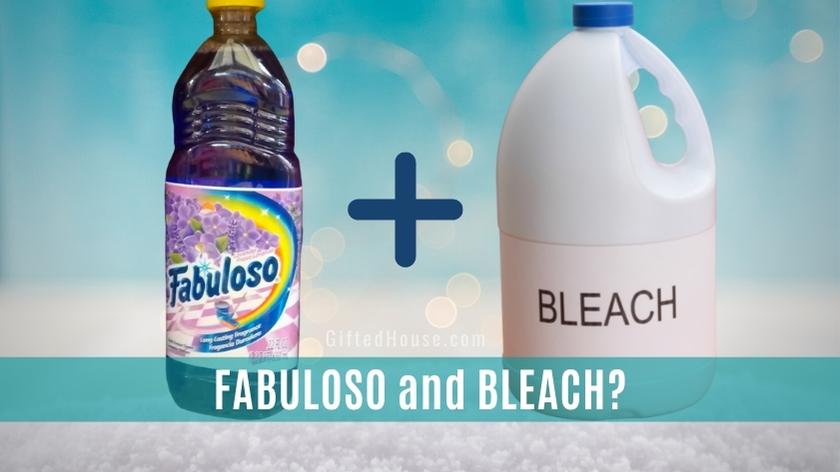Bleach is a commonly-used household disinfectant, and Fabuloso is a fantastic all-purpose cleaner. They say you should use these in separate, consecutive steps to clean and disinfect surfaces in your home, but can’t you save time and just mix them together?
Can You Mix Fabuloso with Bleach?
No, you shouldn’t ever mix bleach and Fabuloso. When these two all-purpose cleaners mix, a chemical reaction takes place that produces chlorine gas – that’s the same lethal gasses the German fired at Allied Forces during WW1. So, mixing bleach and Fabuloso is downright dangerous and potentially deadly.
Why Shouldn’t You Mix Bleach and Fabuloso?
Sodium hypochlorite (NaClO), a powerful disinfectant, is the active ingredient in liquid bleach. Fabuloso contains a host of cleaning chemicals, including sodium dodecylbenzenesulfonate (soap), sodium chloride (salt), and lactic acid (antimicrobial and descaling agent).
When these two liquids mix, lactic acid reacts with sodium hypochlorite, producing chlorine gas. Chlorine gas is a strong-smelling fume that reacts with your lung tissue, destroying it in the process. This causes your lungs to fill with water, which technically kills you through drowning. This is not a pleasant experience, and you’re not likely to survive it.
Mixing bleach with any type of acid produces chlorine gas, so you’re much safer mixing bleach with clean water and nothing else.
What Do You Mix Fabuloso With?
Water. Plain and simple!
Fabuloso is a powerful all-purpose cleaner formulated to disinfect as it cleans. It’s a thick, creamy substance that’s hard to spread while cleaning unless you dilute it with water. The dilution rate depends on what you want to clean. If you’re cleaning excessively grimy areas, use it as-is on a sponge. Apply some elbow grease if needed.
If you’re cleaning stains off carpets and floors, including wood floors, it helps to dilute Fabuloso with water. Lastly, if you’re undertaking routine floor cleaning, the dilution is ¼ cup Fabuloso per gallon of water at room temperature.
Note that Fabuloso isn’t a disinfectant – it’s a strong soap and will clean nearly any dirt off almost all surfaces, but it won’t kill germs. So, suppose you want to disinfect your home. In that case, it’s best to add an extra step to your cleaning routine, disinfecting surfaces after you’ve cleaned off all the detergent.
What Cleaners Can Be Mixed with Bleach?
Bleach should never be mixed with cleaners since it produces lethal chlorine gas. There’s one notable exception to this rule: Laundry detergent.
When washing filthy clothes, it’s appropriate to mix a small amount of bleach with laundry detergent in the washing machine. If you’re not sure that your detergent is safe to use with bleach, rather don’t. It’s better to err on the safe side here, given the dire consequences if you get it wrong.
Bleach in itself is a very effective cleaner and disinfectant. Diluting one teaspoon of bleach in one quart of water forms an inexpensive but highly effective household disinfectant. Use this on your countertops, in bathrooms, and any other frequently-touched surface. This will make your home a safer place for all, especially when one of your family members is ill.
Note that cleaning and disinfecting aren’t the same. Soap, water, and the proverbial elbow grease will clean dirt and grime for nearly any surface. The surface will look and feel clean, but there might still be some germs lurking on the surface, hidden in plain sight. That’s why you need to apply disinfectant to the surfaces regularly. It will kill common bacteria like norovirus, E. coli, Listeria, Salmonella, and MRSA (methicillin-resistant Staphylococcus aureus). It will even kill the dreaded Coronavirus in all its variant.
What About Ammonia?
Many household cleaners, especially bathroom cleaners, have ammonia as the active ingredient. It’s a very effective soap, but also not a disinfectant – that’s why many are tempted to mix it with bleach to disinfect and clean their surfaces on a single step.
Never mix bleach and ammonia, though. When you do, a chemical reaction releases chloramines (NH2Cl). These toxic gases act in much the same way as chlorine gas, affecting your eyes, throat, nose, and lungs. It will cause you to lapse into a coma and kill you in high concentrations.
Note that ammonia is present in urine as well, so be careful when you’re disinfecting diaper pails, cat litter boxes, or toilet bowls. The best approach is to rinse the surface thoroughly with clean water and clean it using a bleach-free cleaning agent. Use bleach to disinfect the surface once you’re satisfied that all (or at least most) of the ammonia is rinsed away.
Chlorine and Chloramine Poisoning Symptoms
If you notice any of the following symptoms, you might be affected by chloramine or chlorine poisoning:
- Nausea
- Coughing
- Shortness of breath
- Chest pain
- Watery eyes
- Irritation in your throat, nose, eyes
- Wheezing
- Fluid in your lungs or pneumonia-like symptoms
If this is the case, contact emergency services immediately. Chloramine and chlorine poisoning are medical emergencies, and you should get to the hospital immediately. Quick action will save your life. While you wait for emergency services to arrive, get some fresh air.
If you can’t get outside, move to the highest location you can find. Chlorine and chloramine are heavier than air, and thus the concentration at higher locations will be lower.


